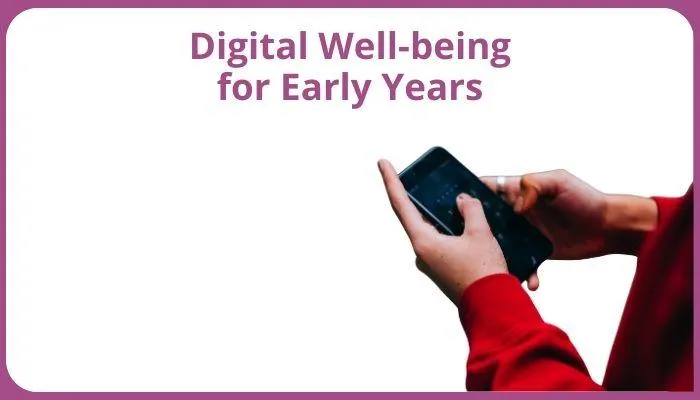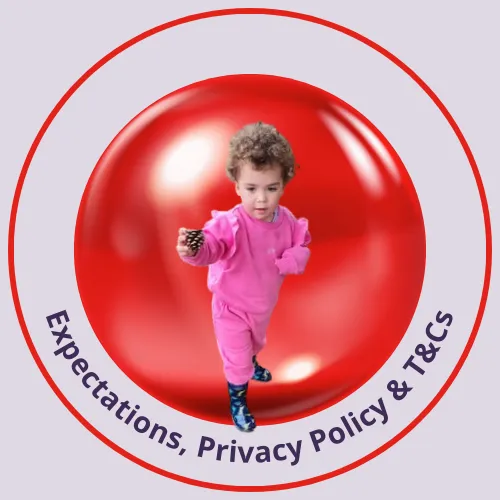Every child's well-being matters.
Well-being Articles

How to Support Digital Well-being for Families and Children in the Early Years
Screens and digital devices are now part of everyday life, even for very young children.
While technology can offer learning opportunities, excessive or inappropriate screen use can impact children’s development, behaviour, and well-being.
Supporting digital well-being in the early years is about creating a healthy balance, helping children engage with technology in a positive way, and ensuring families feel confident in managing screen time.
Why Does Digital Well-being Matter?
Brain Development – Excessive screen time can limit opportunities for real-world interactions, which are crucial for language development and social skills.
Sleep and Physical Health – Too much screen use, particularly before bedtime, can interfere with sleep and reduce active play.
Emotional Regulation – Over-reliance on screens for entertainment can affect children’s ability to manage boredom, frustration, and emotions.
Online Safety – Even young children can be exposed to inappropriate content or digital risks if online activities are not monitored.
How Can Early Years Settings and Parents Support Digital Well-being?
1. Set Healthy Screen Time Boundaries
Follow the NHS recommendation that children under 2 years old should have minimal screen time, and those aged 2-5 should have no more than an hour per day.
Encourage screen-free times, especially during meals and before bedtime.
Balance screen use with active, creative, and social play.
2. Model Healthy Digital Habits
Parents and educators should be mindful of their own screen use. If adults are constantly on their phones, children may see this as normal behaviour.
Demonstrate positive screen use by engaging with children during digital activities rather than using screens as a ‘babysitter.’
3. Prioritise High-Quality Content
Choose age-appropriate, educational apps and programmes that promote interaction, problem-solving, and creativity.
Encourage co-viewing, where adults and children engage with digital content together, discussing what they see and learn.
4. Encourage Real-World Alternatives
Promote activities that support development, such as reading books, outdoor play, arts and crafts, and sensory activities.
If children enjoy watching certain TV shows or games, find ways to bring them to life through role play or storytelling.
5. Support Parents in Navigating Digital Challenges
Provide guidance on managing screen time at home and suggest helpful parental control settings.
Educate families on online safety, including privacy settings, safe browsing, and recognising inappropriate content.
Offer workshops or resources to help parents feel more confident in making informed choices about their child’s digital interactions.
Finding the Right Balance
Digital devices are here to stay, and technology can be a valuable learning tool when used appropriately. The goal is not to ban screens altogether but to encourage mindful and purposeful use. By helping children and families develop healthy digital habits early on, we can create a positive relationship with technology that supports children’s overall well-being.
AUTHOR:- Iona has nearly 10 years of experience supporting nurseries and childminders in curriculum planning, leadership, and safeguarding. Her writing is informed by public information and sector insight, aiming to provide accessible, practical support for professionals working with children. She is part of the On the Button team, helping deliver Well-being, Safeguarding and Complaint Management Software that empowers practitioners to identify concerns early and act confidently.
On the Button provides innovative software tailored to the needs of the early years sector, with a strong focus on EYFS well-being and early years safeguarding. Our tools help senior practitioners to confidently track concerns, maintain robust records, and respond effectively — all while meeting statutory guidance. From early years complaint management to team-wide safeguarding alerts, our platform puts children's safety and emotional health first.

How to Support Digital Well-being for Families and Children in the Early Years
Screens and digital devices are now part of everyday life, even for very young children.
While technology can offer learning opportunities, excessive or inappropriate screen use can impact children’s development, behaviour, and well-being.
Supporting digital well-being in the early years is about creating a healthy balance, helping children engage with technology in a positive way, and ensuring families feel confident in managing screen time.
Why Does Digital Well-being Matter?
Brain Development – Excessive screen time can limit opportunities for real-world interactions, which are crucial for language development and social skills.
Sleep and Physical Health – Too much screen use, particularly before bedtime, can interfere with sleep and reduce active play.
Emotional Regulation – Over-reliance on screens for entertainment can affect children’s ability to manage boredom, frustration, and emotions.
Online Safety – Even young children can be exposed to inappropriate content or digital risks if online activities are not monitored.
How Can Early Years Settings and Parents Support Digital Well-being?
1. Set Healthy Screen Time Boundaries
Follow the NHS recommendation that children under 2 years old should have minimal screen time, and those aged 2-5 should have no more than an hour per day.
Encourage screen-free times, especially during meals and before bedtime.
Balance screen use with active, creative, and social play.
2. Model Healthy Digital Habits
Parents and educators should be mindful of their own screen use. If adults are constantly on their phones, children may see this as normal behaviour.
Demonstrate positive screen use by engaging with children during digital activities rather than using screens as a ‘babysitter.’
3. Prioritise High-Quality Content
Choose age-appropriate, educational apps and programmes that promote interaction, problem-solving, and creativity.
Encourage co-viewing, where adults and children engage with digital content together, discussing what they see and learn.
4. Encourage Real-World Alternatives
Promote activities that support development, such as reading books, outdoor play, arts and crafts, and sensory activities.
If children enjoy watching certain TV shows or games, find ways to bring them to life through role play or storytelling.
5. Support Parents in Navigating Digital Challenges
Provide guidance on managing screen time at home and suggest helpful parental control settings.
Educate families on online safety, including privacy settings, safe browsing, and recognising inappropriate content.
Offer workshops or resources to help parents feel more confident in making informed choices about their child’s digital interactions.
Finding the Right Balance
Digital devices are here to stay, and technology can be a valuable learning tool when used appropriately. The goal is not to ban screens altogether but to encourage mindful and purposeful use. By helping children and families develop healthy digital habits early on, we can create a positive relationship with technology that supports children’s overall well-being.
AUTHOR:- Iona has nearly 10 years of experience supporting nurseries and childminders in curriculum planning, leadership, and safeguarding. Her writing is informed by public information and sector insight, aiming to provide accessible, practical support for professionals working with children. She is part of the On the Button team, helping deliver Well-being, Safeguarding and Complaint Management Software that empowers practitioners to identify concerns early and act confidently.
On the Button provides innovative software tailored to the needs of the early years sector, with a strong focus on EYFS well-being and early years safeguarding. Our tools help senior practitioners to confidently track concerns, maintain robust records, and respond effectively — all while meeting statutory guidance. From early years complaint management to team-wide safeguarding alerts, our platform puts children's safety and emotional health first.

How to Support Digital Well-being for Families and Children in the Early Years
Screens and digital devices are now part of everyday life, even for very young children.
While technology can offer learning opportunities, excessive or inappropriate screen use can impact children’s development, behaviour, and well-being.
Supporting digital well-being in the early years is about creating a healthy balance, helping children engage with technology in a positive way, and ensuring families feel confident in managing screen time.
Why Does Digital Well-being Matter?
Brain Development – Excessive screen time can limit opportunities for real-world interactions, which are crucial for language development and social skills.
Sleep and Physical Health – Too much screen use, particularly before bedtime, can interfere with sleep and reduce active play.
Emotional Regulation – Over-reliance on screens for entertainment can affect children’s ability to manage boredom, frustration, and emotions.
Online Safety – Even young children can be exposed to inappropriate content or digital risks if online activities are not monitored.
How Can Early Years Settings and Parents Support Digital Well-being?
1. Set Healthy Screen Time Boundaries
Follow the NHS recommendation that children under 2 years old should have minimal screen time, and those aged 2-5 should have no more than an hour per day.
Encourage screen-free times, especially during meals and before bedtime.
Balance screen use with active, creative, and social play.
2. Model Healthy Digital Habits
Parents and educators should be mindful of their own screen use. If adults are constantly on their phones, children may see this as normal behaviour.
Demonstrate positive screen use by engaging with children during digital activities rather than using screens as a ‘babysitter.’
3. Prioritise High-Quality Content
Choose age-appropriate, educational apps and programmes that promote interaction, problem-solving, and creativity.
Encourage co-viewing, where adults and children engage with digital content together, discussing what they see and learn.
4. Encourage Real-World Alternatives
Promote activities that support development, such as reading books, outdoor play, arts and crafts, and sensory activities.
If children enjoy watching certain TV shows or games, find ways to bring them to life through role play or storytelling.
5. Support Parents in Navigating Digital Challenges
Provide guidance on managing screen time at home and suggest helpful parental control settings.
Educate families on online safety, including privacy settings, safe browsing, and recognising inappropriate content.
Offer workshops or resources to help parents feel more confident in making informed choices about their child’s digital interactions.
Finding the Right Balance
Digital devices are here to stay, and technology can be a valuable learning tool when used appropriately. The goal is not to ban screens altogether but to encourage mindful and purposeful use. By helping children and families develop healthy digital habits early on, we can create a positive relationship with technology that supports children’s overall well-being.
AUTHOR:- Iona has nearly 10 years of experience supporting nurseries and childminders in curriculum planning, leadership, and safeguarding. Her writing is informed by public information and sector insight, aiming to provide accessible, practical support for professionals working with children. She is part of the On the Button team, helping deliver Well-being, Safeguarding and Complaint Management Software that empowers practitioners to identify concerns early and act confidently.
On the Button provides innovative software tailored to the needs of the early years sector, with a strong focus on EYFS well-being and early years safeguarding. Our tools help senior practitioners to confidently track concerns, maintain robust records, and respond effectively — all while meeting statutory guidance. From early years complaint management to team-wide safeguarding alerts, our platform puts children's safety and emotional health first.

How to Support Digital Well-being for Families and Children in the Early Years
Screens and digital devices are now part of everyday life, even for very young children.
While technology can offer learning opportunities, excessive or inappropriate screen use can impact children’s development, behaviour, and well-being.
Supporting digital well-being in the early years is about creating a healthy balance, helping children engage with technology in a positive way, and ensuring families feel confident in managing screen time.
Why Does Digital Well-being Matter?
Brain Development – Excessive screen time can limit opportunities for real-world interactions, which are crucial for language development and social skills.
Sleep and Physical Health – Too much screen use, particularly before bedtime, can interfere with sleep and reduce active play.
Emotional Regulation – Over-reliance on screens for entertainment can affect children’s ability to manage boredom, frustration, and emotions.
Online Safety – Even young children can be exposed to inappropriate content or digital risks if online activities are not monitored.
How Can Early Years Settings and Parents Support Digital Well-being?
1. Set Healthy Screen Time Boundaries
Follow the NHS recommendation that children under 2 years old should have minimal screen time, and those aged 2-5 should have no more than an hour per day.
Encourage screen-free times, especially during meals and before bedtime.
Balance screen use with active, creative, and social play.
2. Model Healthy Digital Habits
Parents and educators should be mindful of their own screen use. If adults are constantly on their phones, children may see this as normal behaviour.
Demonstrate positive screen use by engaging with children during digital activities rather than using screens as a ‘babysitter.’
3. Prioritise High-Quality Content
Choose age-appropriate, educational apps and programmes that promote interaction, problem-solving, and creativity.
Encourage co-viewing, where adults and children engage with digital content together, discussing what they see and learn.
4. Encourage Real-World Alternatives
Promote activities that support development, such as reading books, outdoor play, arts and crafts, and sensory activities.
If children enjoy watching certain TV shows or games, find ways to bring them to life through role play or storytelling.
5. Support Parents in Navigating Digital Challenges
Provide guidance on managing screen time at home and suggest helpful parental control settings.
Educate families on online safety, including privacy settings, safe browsing, and recognising inappropriate content.
Offer workshops or resources to help parents feel more confident in making informed choices about their child’s digital interactions.
Finding the Right Balance
Digital devices are here to stay, and technology can be a valuable learning tool when used appropriately. The goal is not to ban screens altogether but to encourage mindful and purposeful use. By helping children and families develop healthy digital habits early on, we can create a positive relationship with technology that supports children’s overall well-being.
AUTHOR:- Iona has nearly 10 years of experience supporting nurseries and childminders in curriculum planning, leadership, and safeguarding. Her writing is informed by public information and sector insight, aiming to provide accessible, practical support for professionals working with children. She is part of the On the Button team, helping deliver Well-being, Safeguarding and Complaint Management Software that empowers practitioners to identify concerns early and act confidently.
On the Button provides innovative software tailored to the needs of the early years sector, with a strong focus on EYFS well-being and early years safeguarding. Our tools help senior practitioners to confidently track concerns, maintain robust records, and respond effectively — all while meeting statutory guidance. From early years complaint management to team-wide safeguarding alerts, our platform puts children's safety and emotional health first.




Facebook
Instagram
LinkedIn
Youtube